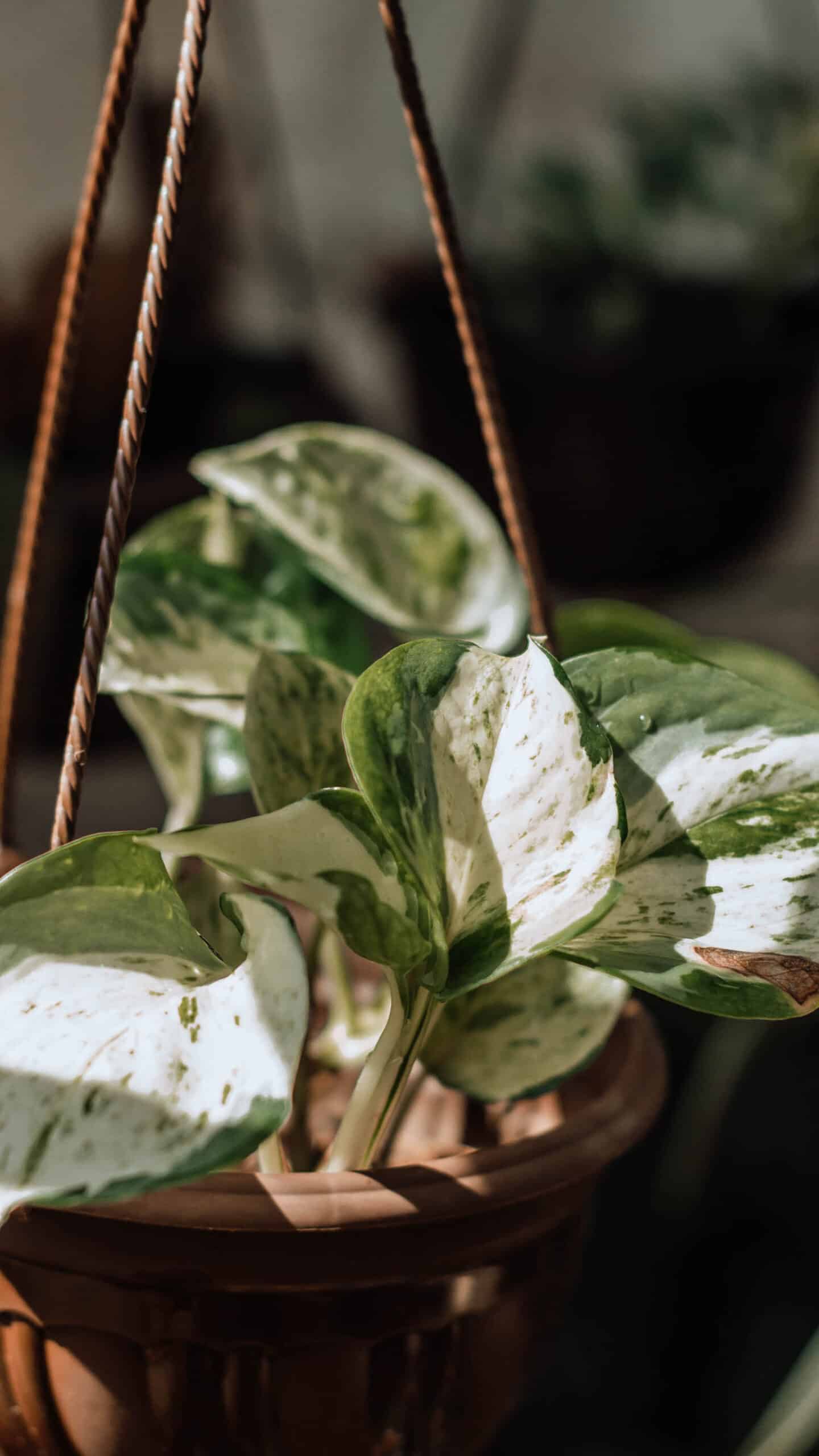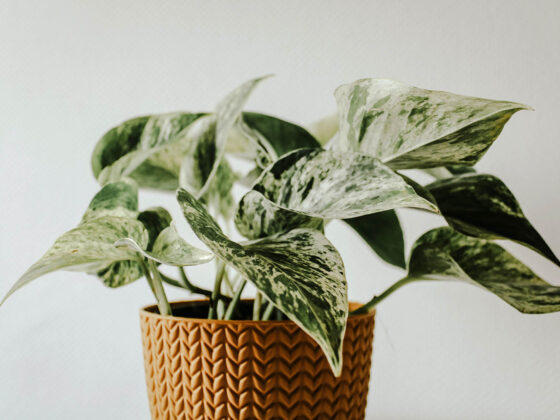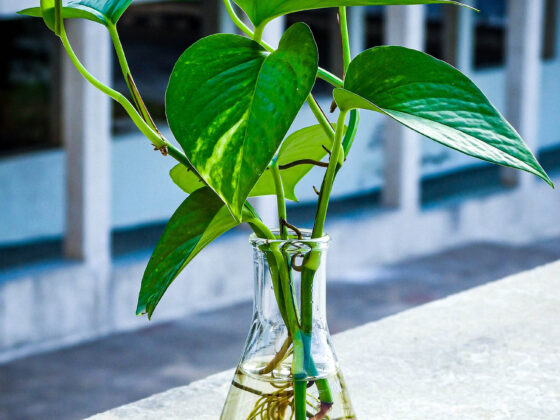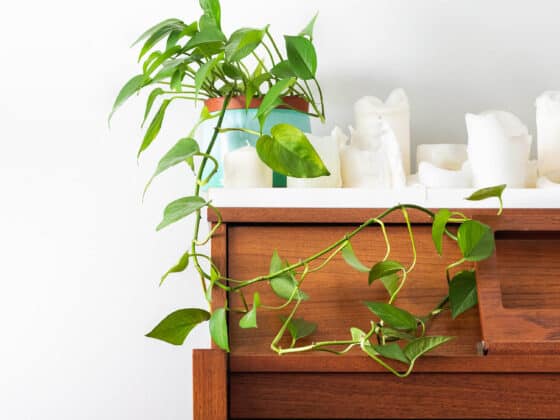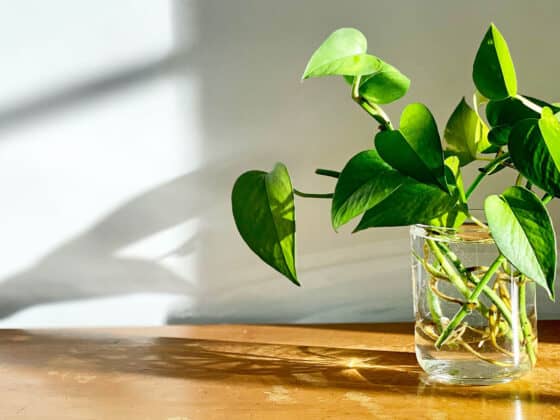You want your Marble Queen Pothos to stay variegated – those sprays of creamy white and minty green are what give your plant its unique style. However, variegated plants don’t always stay variegated. How can you keep a Marble Queen Pothos white and green and stop it from reverting to a single-color plant?
Providing a large amount of bright, indirect light is the best way to keep Marble Queen Pothos white. The plant is likely to start making more chlorophyll if it can’t get enough light, causing it to revert. If your Marble Queen does start turning green, trim away the non-variegated leaves to keep them from spreading.
Naturally, you’ll also need to keep your Marble Queen in good overall health. A stressed-out plant might revert to increase its odds of survival. Even if it doesn’t, the leaves could turn yellow or brown, which will also ruin the look of your Marble Queen Pothos. This post will give you a detailed look at how to keep your plant variegated.
Why Does a Marble Queen Pothos Lose its White Spots?
Some plants – for example, many beautifully patterned Calatheas – have stable variegation. Their multicolored stripes or spots are built right into their genomes, with the relevant DNA in every cell.
That’s not the case with variegated Epipremnum (Pothos) plants like the Marble Queen. These cultivars have chimeric variegation – a mutation that’s distributed through their bodies at random. The cells with this abnormality produce less chlorophyll than normal, causing them to appear light green or creamy white.
As such, each new Marble Queen Pothos leaf is a new spin of the genetic roulette wheel. It’s mostly up to random chance how much of the tissue is variegated. Sometimes the plant will send out fully green growth for no obvious reason. That’s what we call reversion.
Now, you may have noticed that we said this process is mostly random. Certain problems make your plant much more likely to revert. Avoiding those pitfalls is the #1 way to keep a Marble Queen Pothos white.
Sunlight Helps a Marble Queen Keep its White Coloring
Heavily variegated leaves on a Marble Queen Pothos have less chlorophyll than normal, which makes them costlier for the plant to maintain. They take in less solar energy than all-green leaves of the same size. So your Marble Queen needs more sunlight than an ordinary Epipremnum.
Your plant can step up the production of chlorophyll when it senses that it’s not receiving enough solar energy. This may only shift the color balance toward green – instead of leaves that are 50% white, you might get an 80-20 split in favor of green. But a severe enough energy shortage will spur your Marble Queen to make fully green foliage.
A healthy supply of light is the best way to keep a Marble Queen Pothos white. For best results, try to ensure that your plant gets at least 10-12 hours of bright sunlight each day. That may not be possible during the winter, but get as close as you can.
Your Marble Queen Pothos should get mostly indirect light. That means the sun’s rays shouldn’t shine directly on the foliage. More than 2-3 hours of direct sunlight per day can burn and dehydrate the leaves.
How to Keep Your Marble Queen Pothos Well-Lit
Our favorite lighting for a Marble Queen is the kind offered by an east-facing window. The plant will get some bright sun early in the morning, when the cool air can help prevent sun scorch. As the day heats up, the light turns indirect.
A south-facing window is even brighter, but its light can get very harsh in the spring and summer. Set your Marble Queen on a shelf or table 5-6 feet away from the window to get the right balance. Or hang some sheer curtains to diffuse the light a little bit.
Grow lamps are another option – an LED bulb is a cost-effective way to ensure steady light exposure. Pair it with an outlet timer to regulate the day and night cycle and give your Marble Queen a consistent 12 hours of light per day. (Read more about our favorite grow lights in this article.)
If you think your Pothos needs more sun, increase its exposure a little bit each day. Plants are much more likely to get burned if their light levels change suddenly.
Keep Your Marble Queen at a Steady Temperature
Extreme heat or cold stress can also make a Marble Queen Pothos turn green. It’s not clear exactly why this happens. The plant might simply be responding to a survival threat by trying to make its energy intake as efficient as possible.
Keep an eye on the thermostat, especially in the winter, and make sure your Marble Queen’s room stays between 65 and 85 degrees. Even a short cold snap can cause serious stress in a Pothos. Watch out for drafty windows and doors. Avoid excess heat, too – fireplaces and heating vents are not friendly environments for a Pothos.
Many Other Health Issues Can Discolor Your Plant
Care mistakes like overwatering and fertilizer burn might not make your Marble Queen Pothos revert. However, they can ruin its gorgeous coloration with unsightly yellowing, crispy edges, and brown patches. We have a detailed guide to Marble Queen Pothos care, but here are the highlights:
- Use coarse, well-aerated soil. Soil with the right drainage profile helps your Pothos dodge several serious health issues. More than half of the potting mix should be coarse material that doesn’t decay quickly. The rest should be spongy organic matter that retains water.
- Water only when needed. To avoid both underwatering and overwatering, water when the soil dries out instead of on a regular schedule. The simplest method is to test the upper 1-2 inches of the soil with your finger every 2-3 days. If it feels dry, water thoroughly.
- Provide moderate humidity. A Marble Queen Pothos thrives when the relative humidity is between 60% and 70%. If you can’t manage that, at least try to keep it above 50% to avoid crispy leaf edges.
- Fertilize sparingly. During the growing season, give your plant a ¼-strength dose of liquid plant fertilizer every 4-6 weeks. You can increase this if the plant grows too slowly, but watch for dehydrated foliage.
- Repot every two years. Every other year, move your Marble Queen to a new pot that’s about two inches bigger. You might want to do this every year if it’s growing very rapidly, but that’s rare with variegated Pothos plants.
Pruning Can Halt Reversion
You can follow all of the advice above and still find your Marble Queen Pothos turning green. This usually happens because the growth tip shows up in a section of the stem without variegation. If there aren’t at least a few mutated cells in the node, it can not produce variegated stems or leaves.
(For reference, the nodes are the knobby “seams” along the stem. They often look brown and woody compared to the rest of the plant. All new growth comes from the nodes.)

It’s best to clip off this reverted growth. Since all-green leaves absorb more sunlight, they’re more vigorous than the variegated ones. Left to their own devices, this advantage in growth will let the green foliage take over your plant. You need to prune the all-green leaves ASAP if you want to keep a Marble Queen Pothos white.
Get yourself a good set of pruning scissors, and maybe some gardening gloves – the sap of a Pothos can irritate sensitive skin. Then swab the blades with rubbing alcohol or a 10% dilution of household bleach. This reduces the risk that your plant will get an infection when you cut it.
Trace backward from the green growth until you find a node in a clearly multicolored part of the stem. Make your cut just below this spot so that the last node on the vine is variegated. This ensures that the stem will grow back from the non-reverted portion of the plant.
We’d also suggest occasionally propagating some cuttings from your Marble Queen Pothos when it’s not reverting. That way you’ll have some “spare” vines to choose from if the main plant turns green despite your best efforts.
Final Thoughts
You can usually keep a Marble Queen Pothos white with a combination of sunlight, steady temperature, and careful pruning. Those are your best defenses against reversion, but good all-around plant care is also important. The more comfortable your Marble Queen is, the easier it will be to preserve its extravagant coloring.






